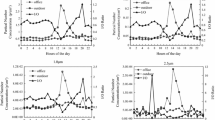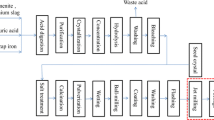Abstract
Object
This research addresses different issues related to the ventilation and the aerosol concentration present in a metal additive manufacturing facility using Laser Powder Bed Fusion (L-PBF) machine. Performing air monitoring requires quantifying the emissions potentially generated in the different areas and during the different L-PBF process phases. A practical Indoor Air Quality (IAQ) assessment protocol is addressed in this research questioning the type of emissions to measure, and the way to collect them.
Methods
As a measurement strategy for the airborne particles lower than 700 nm, real-time metrology discmini instruments were used (Testo, 1 L.min−1, Forbach, France). The particle number concentration was assessed during three operations: (i) before cleaning the room where the L-PBF machine is located, (ii) during the cleaning phase of the room, and (iii) after the cleaning phase.
Results
Without ventilation and without human activity, the background concentration level in the additive manufacturing facility was 5.103 #/cm3 either before or after cleaning. With ventilation and without human activity, the background concentration level was decreased to 4.103 #/cm3 before cleaning, and increased to 1.5.104 #/cm3 after cleaning. Besides, human activity leads to an increase in the number of suspended particles, since they passed from 5.103 #/cm3 to 1.9.104 #/cm3. Finally, a value of 105 #/cm3 was recorded on the operator during the cleaning phase and clearly, show peaks of particle number concentration.
Conclusion
It was found that the local ventilation plays a role in the resuspension of particles from surfaces. Indeed, particles deposited on the floor are a source of exposure and hence the need for a clean room. The result section reinforces the necessity of wearing individual protective equipment during the maintenance and cleaning operations of a facility including L-PBF machine.








Similar content being viewed by others
References
Standards ISO/ASTM 52900 (2015) Additive manufacturing—General principles—Terminology. Switzerland, Geneva
ASTM international (2021) Standards under the jurisdiction of D22. WEB https://ww.astm.org/COMMIT/SUBCOMMITR/D22.htm
Stefaniak AB, du Preez S, du Plessis JL (2021) Additive manufacturing for occupational hygienists: a comprehensive review of processes, emission and exposures. J Toxicology Environ Health, Part B 24(5):173–222. https://doi.org/10.1080/10937404.2021.1936319
Bau S, Rousset D, Payet R, Keller FX (2020) Characterizing particle emissions from a direct energy deposition additive manufacturing process and associated occupational exposure to airborne particles. J Occupat Environ Hygiene 17(2–3):59–72. https://doi.org/10.1080/15459624.2019.1696969
Azzougagh MN, Keller FX, Cabrol E, Cici M, Pourchez J (2021) Occupational exposure during metal additive manufacturing: a case study of laser powder bed fusion of aluminum alloy. J Occupat Environ Hygiene (JOEH) 6:223–236. https://doi.org/10.1080/15459624.2021.1909055
Standards ISO 16000–1 (2004) Indoor air. Part 1: General aspects of sampling strategy
World Health Organization (2010) WHO guidelines for indoor air quality: selected pollutants. Regional Office for Europe publishing physics Web. https ://apps. Who.int/ iris/ handle/10665/260127. Accessed 2010
Bradford BO, Davis WF (1992) Understanding Indoor Air Quality. CRC Press, USA
Hui PS, Wong LT, Mui KW (2009) An indoor air quality monitoring and assessment protocol for air-conditioned offices: a case study of Hong Kong. Paper E9, Conference on Green Building -Towards Eco-City. National Taiwan University of Science and Technology, Taipei, Taiwan, pp 513–524
TSI (2016) Testo DiSCmini Instruction Manual. TSI Publishing books online. https://static-int.testo.com/media/e6/b0/b0ea52f6be7a/testo-DiSCmini-Instruction-manual.pdf. Accessed September 2016
Hui PS, Wong LT, Mui KW (2007) Evaluation of professional choice of sampling locations for indoor air quality. J Build Environ 42(8):2900–2907. https://doi.org/10.1016/j.buildenv.2006.10.039
Shirin K, Maud R, Marin P (2020) Monitoring indoor air quality in additive manufacturing environment. J Procedia CIRP 90:455–460. https://doi.org/10.1016/j.procir.2020.01.113
Chen R, Yin H, Cole IS, Shen S, Zhou X, Wang Y, Tang S (2020) Exposure, assessment and health hazards of particulate matter in metal additive manufacturing: a review. J Chemosphere 259:127–452
Deak SM (1999) Safe work practices for rapid prototyping. J Rapid Prototyp 5(4):161–163. https://doi.org/10.1108/13552549910295479
Du Preez S, Johnson A, Le Bouf RF, Linde SJL, Stefaniak AB, Du Plessis J (2018) Exposures during industrial 3-D printing and post-processing tasks. Rapid Prototyp J 24(5):865–871. https://doi.org/10.1108/RPJ-03-2017-0050
Acknowledgements
Thanks to all the staff of the Addifab platform, and to colleagues at Mines Saint-Etienne who contributed to this study. The INRS organization is greatly thanked for the technical expertise and the high quality measurement equipment.
Author information
Authors and Affiliations
Corresponding author
Ethics declarations
Conflict of interest
Mohamed-Nour Azzougagh, François-Xavier Keller, Mehmet Cici, Elodie Cabrol, Jérémie Pourchez declare that they have no known competing financial interests or personal relationships that might have appeared to influence the work reported in this article.
Ethical statement
This article does not contain any studies with human or animal participants conducted by any of the authors.
Rights and permissions
About this article
Cite this article
Azzougagh, MN., Keller, FX., Cici, M. et al. Ultrafine aerosol transient phase measurement with real-time monitoring instrument applied to cleaning process of L-Pbf machine. Toxicol. Environ. Health Sci. 14, 59–68 (2022). https://doi.org/10.1007/s13530-021-00117-2
Accepted:
Published:
Issue Date:
DOI: https://doi.org/10.1007/s13530-021-00117-2




